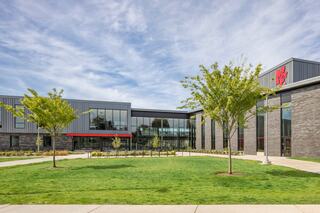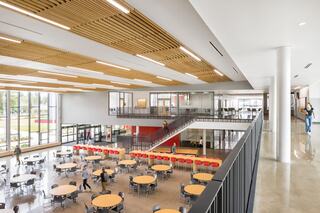North Eugene High School and the Modern Learning Environment

Many of us were lucky to have ample windows in our schools growing up. Windows allow natural light and make classrooms and common areas feel more open, which has been proven to support learning and boost mental health. In recent years, the trend toward better daylighting has become a must-have in today’s learning environments.
Research shows that besides daylight, clean air, good acoustics, and visual connections to the outdoors positively impact student health, learning, productivity, and sense of belonging.
Building the new North Eugene High School was an opportunity to introduce these benefits to current students. Taking the place of a building more than seven decades old is a two-story, 216,000-square-foot new high school with bright and inviting flexible learning spaces. It opened to students this fall.
Many of us were lucky to have ample windows in our schools growing up. Windows allow natural light and make classrooms and common areas feel more open, which has been proven to support learning and boost mental health. In recent years, the trend toward better daylighting has become a must-have in today’s learning environments.
Research shows that besides daylight, clean air, good acoustics, and visual connections to the outdoors positively impact student health, learning, productivity, and sense of belonging.
Building the new North Eugene High School was an opportunity to introduce these benefits to current students. Taking the place of a building more than seven decades old is a two-story, 216,000-square-foot new high school with bright and inviting flexible learning spaces. It opened to students this fall.

Lewis’s team constructed the new North Eugene High School on the west end of the property (pictured on the right) while the old high school remained operational during construction.
Student-centric design
Project architects Rowell Brokaw and Opsis Architecture designed the new school with these elements in mind. Another goal was to maintain part of the visual identity of the old building while taking cues from the surrounding neighborhood.
The new high school is built around a central courtyard, imbuing each classroom with daylight and providing a comfortable place for students to gather and enjoy lunch, learning or outdoor activities. The floor-to-ceiling wall of windows faces the fully landscaped and tree-lined courtyard. In addition to providing wayfinding and orienting students to their surroundings, the windows also provide a vital indoor-outdoor connection.
The staggered wood ceiling slats is another thoughtful design feature that adds warmth to the space and dampens noise.

The new high school was designed and built around a central courtyard, providing a place for students to gather between classes.
Technically challenging spaces
The new school building involved the construction of acoustically sensitive and technically challenging spaces to build, like the 400-seat auditorium, the music band and choir rooms, equipment-dense science labs, a community health clinic, and a large commercial kitchen. Combining all these unique spaces required nuanced phasing and scheduling approaches.
On the surface, building an auditorium seems simple—hang lights, place seating, and add a stage. But as Lewis superintendent Corey Reith explained, “The auditorium was the last thing we finished and the first thing we started.”
Theater seating, for instance, is particularly complex because seats are placed in a radius to provide visibility for each audience member. A variety of seat sizes are necessary to ensure aisle alignment. Field measurements are required to finalize seat sizes, and measurements cannot accurately be recorded until the concrete slab of the raised flooring is complete.
Once ordered, theater seats have a procurement timeline of up to four months to arrive on-site.
Reith and the wider Lewis team came equipped to manage these hurdles through experience building other K-12 schools, like Adrienne Nelson High School in Happy Valley, Oregon.

The auditorium at North Eugene High School.
Different avenues of learning
As experienced builders of K-12 educational facilities, we strongly believe that Career Technical Education (CTE) programs are also an important part of the modern learning environment. CTE programs allow students to learn about and try different career avenues. The new building also brings flexible spaces that support CTE programs, encourage cross-disciplinary discovery, and allow students to do hands-on learning, unlocking their full potential.
The CTE spaces were designed to host classes like wood and metal shops, plus unique courses in culinary arts, child development and education, health sciences, 3D and 2D art, digital media, theater, and more.
“What’s nice about CTE programs is that they’re teaching kids at a young age that trade school is an excellent option after graduating high school,” says Lewis project manager Ashlee Blessing. “Especially for those students that want a different avenue than college or joining the military.”
For Lewis’ director of operations Nate Buddress, who leads the firm’s education market sector in Oregon, the success of any learning environment hinges on how it accommodates change, both in how teachers present information and in the evolving needs of students.
“When we look at the job market, there’s so much diversity in the careers you can take compared to even 10 years ago. It’s no longer the simple math, science, and English courses,” he said. “Twenty-first-century learning is about preparing students for the next phase in their lives. There’s more focus on career opportunities like trades or alternative, newer career paths.”
Buddress reflects on his daughter’s recent classes, which have involved health-professional-related topics like mindful meditation and nutrition—a new kind of focused learning that didn’t exist a few years ago.
“Students should feel empowered to understand their options, the benefits and the training involved in the many paths they can explore to make a living wage and career,” he says.
Like ‘something out of a movie’
After 50 years, this is the first new high school for Eugene School District 4J, and the feedback from the students has been inspiring. “This new school just makes us feel like we are worth something,” sophomore Riley Whitwood told the Eugene Register-Guard. Junior Braysun Puha described walking through the sliding doors and seeing elements like the staircase and cafeteria “as something out of a movie, like ‘High School Musical.’”
When interviewed by KEZI9 News, North Eugene High School principal Naín Muñoz noted that the attendance rate through the first five weeks of the school year is at 90 percent, as compared to the more typical rate of 65 percent to start the year. He attributes the improvement to the district’s investment.
“It … makes the north region and North Eugene students [feel] that they matter,” Muñoz said, “And that we care, and you can see when they show up every day, they light up.”

North Eugene High School students described the cafeteria “as something out of a movie, like High School Musical.”